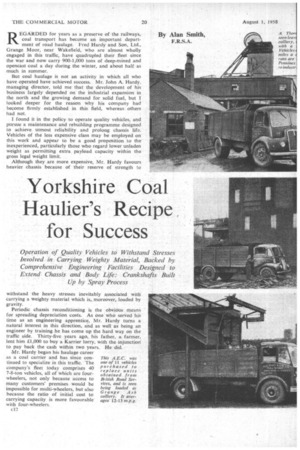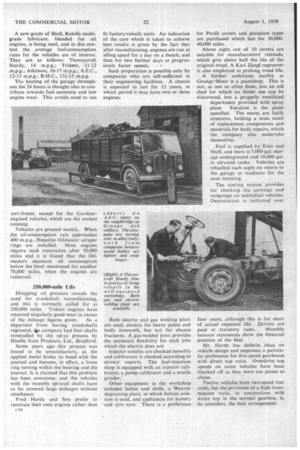Yorkshire Coal Haulier's Recipe for Success
Page 48

Page 49

Page 50

If you've noticed an error in this article please click here to report it so we can fix it.
Operation of Quality Vehicles td Withstand Stresses Involved in Carrying Weighty Material, Backed by Comprehensive Engineering Facilities Designed to Extend: Chassis .and Body Life: Crankshafts Built
. up by Spray Process •
REGARDED for years as a preserve of the railways, coal transport has become an important department of road haulage. Fred Hardy and Son, Ltd., Grange Moor, near Wakefield, who are almost wholly engaged in this traffic, have quadrupled their fleet since the war and now carry 900-1,000 tons of deep-mined and opencast coal a day during the winter, and about half as much in summer.
But coal haulage is not an activity in which all who have operated have achieved success. Mr. John A: Hardy, managing director, told me that the development of his business largely depended on the industrial expansion in the north and the growing demand for solid fuel, but I looked deeper for the reason why his company had become firmly established in this field, whereas others had not.
. I found it in the policy to operate quality vehicles, and pursue a maintenance and rebuilding programme designed to achieve utmost reliability and prolong chassis life. Vehicles of the less expensive class may be employed on this work and appear to be a good proposition to the inexperienced, particularly those who regard lower unladen weight as permitting extra payload capacity within the gross legal weight limit.
Although they are more expensive, Mr. Hardy favours heavier chassis because of their reserve of strength to withstand the heavy stresses inevitably associated with carrying a weighty material which is„ moreover, loaded by gravity.
Periodic chassis reconditioning is the obvious means for spreading depreciation costs. As one who served his time as an engineering apprentice, Mr. Hardy turns a natural interest in this direction, and as well as being an engineer by training he has come up the hard way on the traffic side. Thirty-five years ago, his father, a farmer. lent him £1,000 to buy a Karrier lorry, with the injunction to pay back the cash within two years. He did.
-Mr. Hardy began his haulage career
as a coal carrier and has since conThis A.E.C. was tinued to specialize in this traffic. The one of 11 vehicles
company's fleet today comprises 40 purchased to
7-8-ton vehicles, all of which are fourobtained from wheelers, not only because access to British Road Sermany customers' premises would be vices, and is seen impossible for multi-wheelers, but also being loaded as because the ratio of initial cost to colliery. It aver carrying capacity is more favourable ages 12-13 mpg. with four-wheelers.
ci 2
• Twenty-nine of the vehicles are Thornycroft Sturdy and Trident models covered by ordinary A licences. except for eight B-licence vehicles allowed to carry coal within 30 miles and building materials within 50 miles. Eleven vehicles were acquired from British Road Services, but as their mechanical condition was deplorable they were quickly replaced by six B.Mr.,, three A.E.C. and two Atkinson-Gardner 4LW lorries.
The company are turning over from composite • bodywork to light-alloy bodies built by the Reliance Garage Co. (Brighouse), Ltd., and the Service Garage Co. (Brighouse), Ltd.
It is admitted that aluminium bodywork is more difficult to repair than composite in the event of damage, which is particularly liable to occur with shovel-loading on opencast sites, but this disadvantage is offset as 10 cwt. is saved in unladen weight and light-alloy bodywork lasts longer. Body sides are 3 ft. deep. All tipping gear is made by the Milshaw Tipping Gear Co., Bradford.
Drivers arrive early in the morning and take their vehicles out to collect coal from about two dozen mines and some six opencast sites within 30 miles. Deliveries are made to coal merchants, factories, steelworks, mills, power stations and other coal users in the seven northern counties of England.
_Vehicles cover 100-200 miles a day. Two loads may be delivered a day over the 54-lead to Scunthorpe, and six over a 15-mile journey. Many vehicles do the run over the mountains into industrial Lancashire, for which an amply powerful vehicle is appreciated.
Comparing extreme instances, one vehicle may be 20 minutes s!ower in getting over the Pennines than another, amounting to the loss of about an hour over the day. This makes it impossible to undertake another round trip.
It is not possible to plan work for much more than a day ahead, and there are no regular journeys scheduled to be done by sections of the fleet over specified leads. Mr. J. A. Kaye, transport manager, receives telephone calls from customers and plans a day's operations in readiness for drivers to be instructed when they arrive in the morning. . .
There is occasional work other than coal haulage. . Salt for de-icing roads is carried to local authorities whenever necessary from Winsford, near Man: ehester, and sand and ballast are transported for building during the summer: Mr. Hardy also owns a coal merchant's business at Honley, near Huddersfield; in connection with which an Austin oiler and a Bedford petrol lorryare operated, and a sand quarry at Ripon.
Vehicles are all garaged under cover at Grange Moor in a building 66 ft. wide by 140 ft. king. Two men are employed under Mr. Bob Benson, fleet engineer, on maintenance work; a surprisingly smaller workshop staff than the extent of the company's servicing and reconditioning programme might indicate. Their task is. however, eased by the varied range of machinery and special tools which has been gathered together.
It includes such items as a Newton dynamo and starter tester, and Merlin fuel-injection testingand *conditioning equipment. One would not normally today expect to find appliances of this speciality, provided for a fleet even twice the size of Hardy's. Their presence is explained by the company's desire for independence from outside contractors. The only operations which are sent out are crankshaft grinding and line boring.
Mr. Hardy is a great believer in changing engine oil at frequent intervals. "The cheapest repair there is," he says. The task is done fortnightly. A new grade of Shell, Rotella multigrade lubricant, blended for oil engines, is being used, and in this context the average fuel-consumption rates for the vehicles are of interest. They are as follows: Thornycroft Sturdy, 14 m.p.g.; Trident, 11-12 m.p.g.; Atkinson, 16-17 m.p.g.; A.E.C., 12-13 m.p.g.; 131-15 m.p.g.
The heating of the garage throughout the 24 hours is thought also to contribute towards fuel economy and low engine wear. This avoids need to use anti-freeze, except for the Gardnerengined vehicles, which are the coolest running.
Vehicles are greased weekly. When the oil-consumption rate approaches 400 m.p.g., Hepolite Oilmaster scraper rings are installed. Most engines require such renovation after 50,000 miles and it is found that the Oilmasters maintain oil consumption below the level mentioned for another 70,000 miles, when the engines are resleeved.
250,000-mile Life
Dropping oil pressure reveals the need for crankshaft reconditioning, and this is normally called for at 250,000 miles. Trident engines have returned singularly good wear in excess of the 'mileage figures given. As a departure from having crankshafts reground, tke company had four shafts remetalled by the spray process by Hindle Auto Products, Ltd., Bradford.
Some years ago this process• was found to be unsatisfactory, as the applied metal broke its bond with the journal and became, in effect, a loose ring turning within the bearing and the journal. It is claimed that this problem has been overcome, and the vehicles with the recently sprayed shafts have so far covered large mileages without• mischance.
Fred Hardy and Son prefer to renovate their own engines rather than cl4
fit factory-rebuilt units. An indication of the care which is taken to achieve best results is given by the fact that after reconditioning, engines are run at idling speed for a day on a bench, and then for two further days at progressively faster speeds.
Such preparation is possible only by companies who are self-sufficient in their engineering facilities. A chassis is expected to last for 12 years, in which period it may have two or three engines.
Both electric and gas welding plant are used, electric for heavy joints and body ironwork, but not for chassis fractures. A gas-welded joint provides the necessary flexibility for such jobs which the electric does not.
Injector nozzles are checked monthly and calibration is checked according to drivers' reports. The fuel-injection shop is equipped with an injector calibrator, a pump calibrator and a nozzle grinder.
Other equipment in the workshop includes lathes and drills, a Weaver degreasing plant, in which Solvex solution is used, and appliances for battery • and tyre care. There is a preference for Pirelli covers and premium types are purchased which last for 30,00040,000 miles.
About eight out of 10 covers are suitable for manufacturers' retreads, which give about half the life of the original tread. A Karl ZangI regroover is also employed to prolong tread life.
A further ambitious facility at Grange Moor is a paintshop. This is not, as one so often finds, just an old shed for which no better use can be discovered, but a properly ventilated department provided with spray plant. Tekaloid is the paint specified. The stores are fairly extensive, holding a wide stock of replacement components and materials for body repairs, which the company also undertake themselves.
Fuel is supplied by Esso and Shell. and there is 5,000 gal: storage underground and 10,000 gal. in elevated tanks. Vehicles are refuelled each night on return to the garage in readiness for the next morning.
The costing system proliides for checking—the earnings and outgoings on individual vehicles. Depreciation is reckoned over four years, although this is far short of actual expected life. Drivers are paid at statutory rates. Monthly balance statements show the financial position of the fleet.
Mr. Hardy has definite ideas on vehicle design and expresses a particular preference for five-speed gearboxes with direct top ratio. Overdrive top speeds on some vehicles have been blanked off as they were too prone to abuse.
Twelve vehicles have two-speed rear axles, but the provision of a high transmission ratio, in conjunction with direct top in the normal gearbox, is, he considers, the best arrangement.
































































































